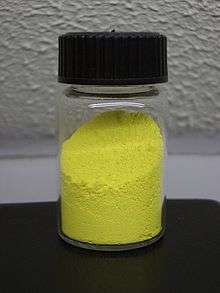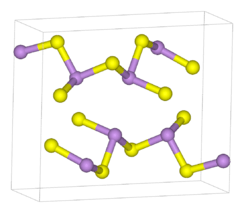Chalcogenide
A chalcogenide is a chemical compound consisting of at least one chalcogen anion and at least one more electropositive element. Although all group 16 elements of the periodic table are defined as chalcogens, the term chalcogenide is more commonly reserved for sulfides, selenides, tellurides, and polonides, rather than oxides.[1] Many metal ores exist as chalcogenides. Photoconductive chalcogenide glasses are used in xerography. Some pigments and catalysts are also based on chalcogenides. The metal dichalcogenide MoS2 is a common solid lubricant.
 Cadmium sulfide, a prototypical metal chalcogenide, is used as a yellow pigment.
Cadmium sulfide, a prototypical metal chalcogenide, is used as a yellow pigment.
Alkali metal and alkaline earth chalcogenides
Alkali metal and alkaline earth monochalcogenides are salt-like, being colourless and often water-soluble. The sulfides tend to undergo hydrolysis to form derivatives containing bisulfide (SH−) anions. The alkali metal chalcogenides often crystallize with the antifluorite structure and the alkaline earth salts in the sodium chloride motif.
 The zinc blende structure is a common motif for metal monochalcogenides.
The zinc blende structure is a common motif for metal monochalcogenides.
Transition metal chalcogenides
Transition metal chalcogenides occur with many stoichiometries and many structures.[2] Most common and most important technologically, however, are the chalcogenides of simple stoichiometries, such as 1:1 and 1:2. Extreme cases include metal-rich phases (e.g. Ta2S), which exhibit extensive metal-metal bonding,[3] and chalcogenide-rich materials such as Re2S7, which features extensive chalcogen-chalcogen bonding.
For the purpose of classifying these materials, the chalcogenide is often viewed as a dianion, i.e., S2−, Se2−, Te2−, and Po2−. In fact, transition metal chalcogenides are highly covalent, not ionic, as indicated by their semiconducting properties.[2]
Metal-rich chalcogenides

In most of their chalcogenides, transition metals adopt oxidation states of II or greater. Nonetheless, several examples exist where the metallic atoms far outnumber the chalcogens. Such compounds typically have extensive metal-metal bonding.[5]
Monochalcogenides
Metal monochalcogenides have the formula ME, where M = a transition metal and E = S, Se, Te. They typically crystallize in one of two motifs, named after the corresponding forms of zinc sulfide. In the zinc blende structure, the sulfide atoms pack in a cubic symmetry and the Zn2+ ions occupy half of the tetrahedral holes. The result is a diamondoid framework. The main alternative structure for the monochalcogenides is the wurtzite structure wherein the atom connectivities are similar (tetrahedral), but the crystal symmetry is hexagonal. A third motif for metal monochalcogenide is the nickel arsenide lattice, where the metal and chalcogenide each have octahedral and trigonal prismatic coordination, respectively. This motif is commonly subject to nonstoichiometry.[6]
Important monochalcogenides include some pigments, notably cadmium sulfide. Many minerals and ores are monosulfides.[1]
Dichalcogenides
Metal dichalcogenides have the formula ME2, where M = a transition metal and E = S, Se, Te.[7] As usual, the most important members are the sulfides. They are always dark diamagnetic solids, insoluble in all solvents, and exhibiting semiconducting properties. In terms of their electronic structures, these compounds are usually viewed as derivatives of M4+, where M4+ = Ti4+ (d0 configuration), V4+ (d1 configuration), Mo4+ (d2 configuration). Titanium disulfide was investigated in prototype cathodes for secondary batteries, exploiting its ability to reversibly undergo intercalation by lithium. Molybdenum disulfide, the subject of many thousand publications, is the main ore of molybdenum where it is called molybdenite. It is used as a solid lubricant and catalyst for hydrodesulfurization. The corresponding diselenides and even ditellurides are known, e.g., TiSe2, MoSe2, and WSe2.
 MoS2, the most common metal dichalcogenide, adopts a layered structure.
MoS2, the most common metal dichalcogenide, adopts a layered structure.
Transition metal dichalcogenides typically adopt either cadmium diiodide or molybdenum disulfide structures. In the CdI2 motif, the metals exhibit octahedral structures. In the MoS2 motif, which is not observed for dihalides, the metals exhibit trigonal prismatic structures.[1] The strong bonding between the metal and chalcogenide ligands, contrasts with the weak chalcogenide—chalcogenide bonding between the layers. Owing to these contrasting bond strengths, these materials engage in intercalation by alkali metals. The intercalation process is accompanied by charge transfer, reducing the M(IV) centers to M(III).
Pyrite and related disulfides
In contrast to classical metal dichalcogenides, iron pyrite, a common mineral, is usually described as consisting of Fe2+ and the persulfido anion S22−. The sulfur atoms within the disulfido dianion are bound together via a short S-S bond.[2] "Late" transition metal disulfides (Mn, Fe, Co, Ni) almost always adopt the pyrite or the related marcasite motif, in contrast to early metals (V, Ti, Mo, W) which adopt 4+ oxidation state with two chalcogenide dianions.
Tri- and tetrachalcogenides
Several metals, mainly for the early metals (Ti, V, Cr, Mn groups) also form trichalcogenides. These materials are usually described as M4+(E22−)(E2−) (where E = S, Se, Te). A well known example is niobium triselenide. Amorphous MoS3 is produced by treatment of tetrathiomolybdate with acid:
- MoS42− + 2 H+ → MoS3 + H2S
The mineral patrónite, which has the formula VS4, is an example of a metal tetrachalcogenide. Crystallographic analysis shows that the material can be considered a bis(persulfide), i.e. V4+,(S22−)2.[2]
Main group chalcogenides
 As2S3 is a crosslinked polymer where the As and S centers obey the octet rule.
As2S3 is a crosslinked polymer where the As and S centers obey the octet rule.
Chalcogen derivatives are known for all of the main group elements except the noble gases. Usually, their stoichiometries follow the classical valence trends, e.g. SiS2, B2S3, Sb2S3. Many exceptions exist however, e.g. P4S3 and S4N4. The structures of many main group materials are dictated by directional covalent bonding, rather than by close packing.[1]
The chalcogen is assigned positive oxidation states for the halides, nitrides, and oxides.
References
- Greenwood, N. N.; & Earnshaw, A. (1997). Chemistry of the Elements (2nd Edn.), Oxford:Butterworth-Heinemann. ISBN 0-7506-3365-4.
- Vaughan, D. J.; Craig, J. R. “Mineral Chemistry of Metal Sulfides" Cambridge University Press, Cambridge: 1978. ISBN 0521214890.
- Hughbanks, Timothy (1995). "Exploring the metal-rich chemistry of the early transition elements". Journal of Alloys and Compounds. 229: 40–53. doi:10.1016/0925-8388(95)01688-0.
- Franzen, H.F.; Beineke, T.A.; Conrad, B.R. (1968). "The crystal structure of Nb21S8". Acta Crystallographica B. 24: 412-p416.
- Franzen, Hugo F. (1978). "Structure and Bonding of Metal-Rich Compounds: Pnictides, chalcogenides and halides". Progress in Solid State Chemistry. 12: 1–39. doi:10.1016/0079-6786(78)90002-X.CS1 maint: uses authors parameter (link)
- "Sulfide Mineralogy: Volume 1" Paul H. Ribbe, editor, 1974, Mineralogical Society of America. ISBN 0-939950-01-4
- Wells, A.F. (1984) Structural Inorganic Chemistry, Oxford: Clarendon Press. ISBN 0-19-855370-6.
External links
- Advanced Chalcogenide Technologies and Applications Lab ACTAlab Jun 14, 2016
- Phase change memory-based 'moneta' system points to the future of computer storage ScienceBlog Jun 03, 2011
- Kovalenko, Maksym V.; Scheele, Marcus; Talapin, Dmitri V. "Colloidal Nanocrystals with Molecular Metal Chalcogenide Surface Ligands". Science. 324: 1417–1420. Bibcode:2009Sci...324.1417K. doi:10.1126/science.1170524.
- Big Blue boffins hatch dirt-cheap solar cells The Register, 12 February 2010